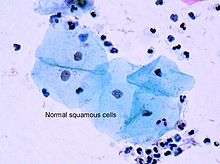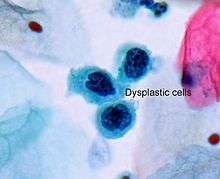Dysplasia
Dysplasia is any of various types of abnormal growth or development of cells (microscopic scale) and/or organs (macroscopic scale), and/or the abnormal histology or anatomical structure presumably resulting from such growth.[1] Dysplasias on a mainly microscopic scale include epithelial dysplasia and fibrous dysplasia of bone. Dysplasias on a mainly macroscopic scale include hip dysplasia, myelodysplastic syndrome, and multicystic dysplastic kidney. In one of the modern histopathologic senses of the term, dysplasia is sometimes differentiated from other categories of tissue change including hyperplasia, metaplasia, and neoplasia, and dysplasias are thus generally not neoplastic (not cancerous). An exception is that the myelodysplasias include a range of benign, precancerous, and cancerous forms. Various other dysplasias tend to be precancerous. The word's meanings thus span across a spectrum of histopathologic variations.


Mainly microscopic scale
Epithelial dysplasia
| -plasia and -trophy |
|---|
|
|
Epithelial dysplasia consists of an expansion of immature cells (such as cells of the ectoderm), with a corresponding decrease in the number and location of mature cells. Dysplasia is often indicative of an early neoplastic process. The term dysplasia is typically used when the cellular abnormality is restricted to the originating tissue, as in the case of an early, in-situ neoplasm.
Dysplasia, in which cell maturation and differentiation are delayed, can be contrasted with metaplasia, in which cells of one mature, differentiated type are replaced by cells of another mature, differentiated type.
Myelodysplastic syndrome
Myelodysplastic syndromes (MDS) are a group of cancers in which immature blood cells in the bone marrow do not mature and therefore do not become healthy blood cells.[2] Problems with blood cell formation result in some combination of low red blood cells, low platelets, and low white blood cells.[2] Some types have an increase in immature blood cells, called blasts, in the bone marrow or blood.[2]
Mainly macroscopic scale
Hip dysplasia
Hip dysplasia is an abnormality of the hip joint where the socket portion does not fully cover the ball portion, resulting in an increased risk for joint dislocation.[4] Hip dysplasia may occur at birth or develop in early life.[4] Regardless, it does not typically produce symptoms in babies less than a year old.[5] Occasionally one leg may be shorter than the other.[4] The left hip is more often affected than the right.[5] Complications without treatment can include arthritis, limping, and low back pain.[5]
Multicystic dysplastic kidney
Multicystic dysplastic kidney (MCDK) is a condition that results from the malformation of the kidney during fetal development. The kidney consists of irregular cysts of varying sizes. Multicystic dysplastic kidney is a common type of renal cystic disease, and it is a cause of an abdominal mass in infants.[6]
Etymology
From Ancient Greek δυσ- dys-, "bad" or "difficult" and πλάσις plasis, "formation". The equivalent surface analysis, in parallel with classical compounds, is dys- + -plasia.
References
- "Definition of dysplasia". Merriam-Webster dictionary. Retrieved 2019-09-09.
- "Myelodysplastic Syndromes Treatment (PDQ®)–Patient Version". NCI. 12 August 2015. Archived from the original on 5 October 2016. Retrieved 27 October 2016.
- Boyce, Alison M.; Collins, Michael T. (1993-01-01). Pagon, Roberta A.; Adam, Margaret P.; Ardinger, Holly H.; Wallace, Stephanie E.; Amemiya, Anne; Bean, Lora JH; Bird, Thomas D.; Fong, Chin-To; Mefford, Heather C. (eds.). Fibrous Dysplasia/McCune-Albright Syndrome. Seattle (WA): University of Washington, Seattle. PMID 25719192.
- "Your Orthopaedic Connection: Developmental Dysplasia of the Hip". October 2013.
- Shaw, BA; Segal, LS; SECTION ON, ORTHOPAEDICS. (December 2016). "Evaluation and Referral for Developmental Dysplasia of the Hip in Infants". Pediatrics. 138 (6): e20163107. doi:10.1542/peds.2016-3107. PMID 27940740.
- Multicystic Dysplastic Kidney Imaging at eMedicine
Further reading
- Noel Weidner (editor), Richard Cote, Saul Suster, Lawrence Weiss (2003). Modern Surgical Pathology. London: W.B. Saunders. ISBN 978-0-7216-7253-3. OCLC 50244347.CS1 maint: multiple names: authors list (link)
- Ramzi S. Cotran, Vinay Kumar, Tucker Collins (Editor) (1999). Robbins Pathologic Basis of Disease (6th ed.). London: W.B. Saunders. ISBN 978-0-7216-7335-6. OCLC 39465455.CS1 maint: multiple names: authors list (link) CS1 maint: extra text: authors list (link)